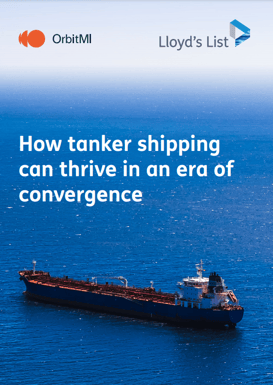
Over the past few years, pressure from maritime regulators has continued to mount; sustainability and decarbonisation rose to become some of the most pressing issues facing the maritime industry. As bodies like the IMO and EU have begun to lay down waypoints and set goals in the race to zero net emissions, shipping companies have been doing their part— developing new technologies, methods, and vessels to decrease emissions. As sustainability policy more and more takes center stage, emerging as one of the factors that will guide the future of maritime, we wanted to create a resource that would help you stay informed. After all, sustainability is something that is at the core of Orbit; per 100 vessel fleet, Orbit users consume 19,800 fewer tonnes of bunker fuel annually, which equates to 61,380 fewer tonnes of CO2. Read on to learn about the current state of sustainability policy, how to drive decarbonisation goals, and how Orbit can help.
The maritime industry is quite carbon-intensive (though you probably already knew that); according to the International Energy Agency (IEA), maritime operations emitted a total of 714 million tonnes of CO2 in 2019 alone, which at the time was equivalent to 2% of global emissions. Simultaneously, the IEA found that low-carbon fuel had a miniscule .1% share of the maritime fuel market. While 2020 saw a 4.1% decrease in maritime trade volume, the United Nations Conference on Trade and Development (UNCTAD) has projected a 4.8% increase in 2021, meaning more voyages, more vessels, and ultimately, more emissions. As a result, regulatory bodies such as the IMO and EU have begun to institute new rules and regulations with the aim of the shipping industry’s total decarbonisation.
Beginning in 2008, the IMO developed and approved a new series of new guidelines that set emissions limits and decarbonisation goals for the decades to come, culminating in last year’s IMO 2020, which notably limited the sulphur content permissible in fuel oil. Since then, IMO 2020 has been somewhat overshadowed by the significant regulatory action coming from the European Union. On July 14th, the EU’s European Commission approved its new strategy for emissions reduction and decarbonisation. Referred to as “Fit for 55,” the binding plan seeks to reduce greenhouse gas emissions from the entire European bloc by 55% within the decade. Fit for 55 enacts a comprehensive series of regulations and taxes, including new emissions trading requirements, greenhouse gas intensity limits, and a tax on bunkers. Failure to comply with both EU and IMO regulation carries with it the risk of severe fines, or in the case of the EU, a ban from EU ports.
With these facts in mind, it is somewhat obvious to say that these regulations pose significant challenges for maritime companies around the globe. We are entering into a new era of maritime operations, one where emissions and carbon reduction are among the keys to success; it will be possible to thrive in this new environment through not only the manufacture of low-pollution vessels, but through efficient vessel operation, and the adoption of streamlined workflows. In the next section, let’s take a look at some of the ways it’s possible to reduce emissions and meet sustainability goals.
Read more:
When evaluating the ways in which the emissions problem might be solved, one of the simplest and most apparent solutions is to count on the development of new vessels. At some point in the future the global fleet will be completely transformed with hyper-efficient vessels that consume ultra-low emissions fuels. Unfortunately that reality is decades away, and even then, simply upgrading the global fleet is not enough to meet future emissions goals. Emissions is a function of many factors, not just the vessel itself— this includes, but is not limited to:
With this large diversity of contributing factors, it becomes more clear why pursuing an efficient decarbonisation strategy means more than just ordering a new fleet—it turns out that will only go so far. In order to effectively achieve emissions reduction targets, new vessels must be used in conjunction with efficient decision making and voyage planning. Tens of thousands of people come to work every day both on ship and on shore—each makes decisions that impact efficiency, profitability and the decarbonisation of their vessels and fleets. These people work in a wide variety of roles and positions— operations, chartering, technical management, the bunker desk, risk claims, demurrage, legal and finance, not to mention all the people who work at ports and other support functions. Think of how many decisions they make every day, every week, and every month, quarter over quarter.
Effective decarbonisation means making all these individual decisions in the most informed manner possible— where to lift bunkers? Which route to follow? Which cargos to pursue? How fast to steam? How long to sit idle at port? When to dry dock? Which berth will expedite discharging? Such efficiency requires the collaboration of people, the coordination of systems, and the transmissions and curation of data across all of those workflows. It turns out that all those “little” things add up- to give you a picture of the quantity of carbon that is the product of inefficient decision making, per 100 vessel fleet, Orbit users emit 61,380 fewer tonnes of CO2. Effective decarbonisation is a many-pronged strategy, but one key component is people. To read more about how people drive sustainability in shipping, click below.
Read more:
People are a significant part of any effective decarbonisation strategy, but so are the systems that they use. Even if the people in question possess all the data necessary to make perfectly efficient decisions, that information is useless if it is hampered by ineffective, siloed systems. OrbitMI CEO, Ali Riaz, refers to this problem as “data latency,” saying that “for insights to have value, they must arrive on time.” As the quantity of available data and maritime regulation— thus well as the burden of compliance, continues to grow in the coming years, it will become increasingly necessary to eliminate data latency from the equation.
Currently teams must log in and out of several systems, cut-and-paste data into spreadsheets, and perform ad hoc analysis. By the time these steps are completed, it’s likely too late. As a result of data latency, you either lose your fixture, or fail to comply with regulation, incurring a hefty fine. Effective decarbonisation requires not only teams that make efficient decisions, but systems that enable them to do so. By streamlining workflows, work becomes not only more efficient, but easier as well. Efficient systems and workflows are the foundation of an effective decarbonisation and sustainability strategy, as they give your teams the tools they need to make sustainable decisions.
Read more:
 How Tanker Shipping Can Thrive in an Era of Convergence
How Tanker Shipping Can Thrive in an Era of ConvergenceThe maritime economy is changing. Read more about how the tanker industry can adapt and thrive through sharing in this report from Lloyd's List.